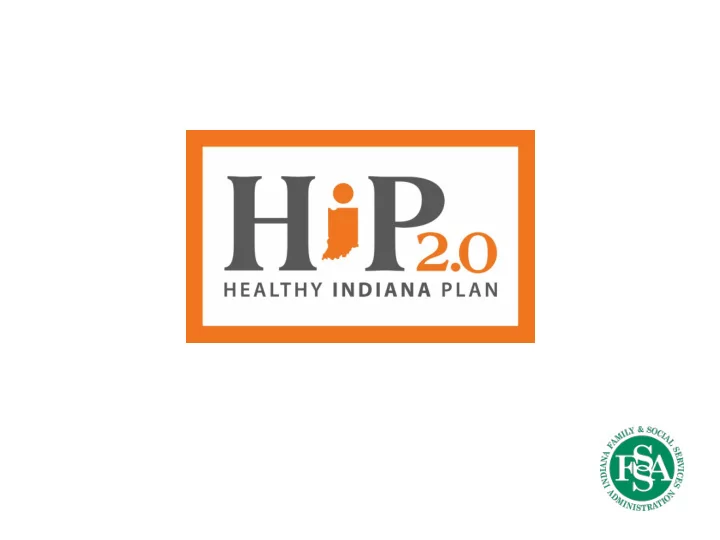

Healthy Indiana Plan First Medicaid plan with strong consumer-directed features (2008) HDHP • POWER Account • Consumer choice + Provider engagement • Proven Results Improves healthcare utilization • Promotes personal ownership of health care • High Member and Provider Satisfaction Enhanced coverage • Enhanced provider reimbursement • 2
HIP 2.0 Eligibility • Indiana residents ages 19 to 64 • income under 138% of the federal poverty Who is level (FPL) • who are not eligible for Medicare or otherwise eligible for eligible for Medicaid HIP 2.0? • Includes individuals previously enrolled in: Healthy Indiana Plan (HIP 1.0) Hoosier Healthwise (HHW) 3
HIP 2.0: Three Pathways to Coverage • Initial plan selection for all members • Benefits : Comprehensive coverage with enhanced benefits , including vision, dental, bariatric, pharmacy HIP Plus • Cost sharing : • Monthly POWER account contribution required • Contribution is 2% of income with a minimum of $1 per month • ER copayments only • Fall-back for members with income <100% FPL who do not make POWER account contribution • Benefits : Minimum coverage, no vision or dental HIP Basic coverage • Cost sharing : • Must pay copayment ranging from $4 to $75 for doctor visits, hospital stays, and prescriptions • Employer plan premium assistance paired with HSA- like account HIP Link • Enhanced POWER account to pay for premiums, deductibles and copays in employer-sponsored plans • Provider reimbursement at commercial rates 4
“Managed Care Entities” (MCEs) Also known as “health plans” Anthem, CareSource, MDwise, MHS New members select MCE • On application OR • Call enrollment broker after application OR • Auto-assigned Once enrolled, call MCE with provider/benefit questions: • Anthem: (866) 408-6131 • CareSource: (844) 607-2829 • MDWise: (800) 356-1204 • MHS: (877) 647-4848 5
Income limits Monthly Income Limits for HIP 2.0 Plans # in household HIP Plus Income up to ~138% FPL* 1 $1,382.54 2 $1,864.33 3 $2,346.12 4 $2,827.91 Annual Income Limits for HIP 2.0 Plans # in household HIP Plus Income up to ~138% FPL* 1 $16,590.48 2 $22,371.96 3 $28,153.44 4 $33,934.92 *133% + 5% income disregard, income limit for HIP program. Eligibility threshold is not rounded. 6
HIP Plus: POWER Account Contributions POWER account contributions are approximately 2% of member income Minimum contribution is $1 per month* • Maximum contribution is $100 per month (individual enrollee in a 9 • person household earning $62,000/year) Employers & not-for-profits may assist with contributions Employers and not-for-profits may pay up to 100% of member PAC • Ideally, payments are made by individual directly to member’s selected • managed care entity Contribution amount based on family income If spouses both enrolled, they split the monthly amount *Approximately 20% of HIP eligible population will have an income the corresponds with the minimum $1 PAC 7
HIP Plus: POWER Account Contributions Monthly POWER account contribution examples* Monthly Income/PAC Monthly Income/PAC FPL Individual Household of 4 22% $216 = $4.32 $445 = $8.90 50% $491 = $9.82 $1,010 = $20.22 75% $736 = $14.72 $1,516 = $30.32 100% $981 = $19.62 $2,021 = $40.42 138% $1,369 = $27.39 $2,822 = $56.44 8 *Amounts can be reduced by other Medicaid or CHIP premium costs
Ways to Pay the POWER Account Contribution Regardless of health plan members can pay by: Credit or debit card (including prepaid cards) • Over the phone o Online o Check or money order • Automatic bank draft • Electronic funds transfer • Payroll deduction • Cash, at one of the following locations: • Anthem MHS MDwise Pay at any Wal-Mart Pay by Western Union Pay at a Fifth Third Pay at any Wal-Mart Bank Pay at any Wal-Mart 9
Co-payment Amounts – HIP Basic * *$8 for first non-emergent emergency department (ED) visit; $25 for any additional 10
Emergency Department (ED) Copayment Collection HIP features a graduated ED copayment model HIP requires non-emergent ED copayments unless: • Member calls MCE Nurse-line prior to visit or • The visit is a true emergency $8 $25 Each 1 st non-emergent additional ED visit in the non-emergent benefit period ED visit in the benefit period 11
HIP Employer Link Premium Assistance Program HIP Employer Link Overview • HIP Employer Link helps employees pay for the costs of their employer coverage. • Members get a $4,000 POWER account. • Members receive a monthly check to help cover the cost of employer premiums. • Like HIP, HIP Link members contribute 2% of their income towards the costs of coverage. • POWER account also helps cover member cost sharing. • Members can use their HIP Employer Link card to pay for copayments, deductibles and coinsurance. 12
HIP 2.0 Gateway to Work All individuals who complete the application for HIP coverage will be connected to job training and job search programs offered by the State of Indiana Voluntary Program – Does not affect eligibility Members will receive letters, can call (800) 403-0864 to sign up 13
Applying for HIP: Indiana Application for Health Coverage Estimate eligibility and POWER account contribution amounts with the online calculator at: http://www.in.gov/fssa/hip/2352.htm Apply for HIP: 1. Online Health Coverage Application available at: https://www.ifcem.com/CitizenPortal/ application.do# 2. Visit a DFR office (http://www.in.gov/fssa/dfr/2999.htm) 3. Paper Application – by fax or mail 4. Phone Application Single application for all coverage programs Find a local navigator to help with enrollment at: 14 http://www.in.gov/healthcarereform/2468.htm
In summary: HIP 2.0… Is Indiana-specific solution • Establishes our own priorities • Builds off of successful program Expands coverage AND improves access Consumer-directed (ownership) • Price transparency • Patient/provider partnership • Focus is on healthy outcomes 15
Recommend
More recommend